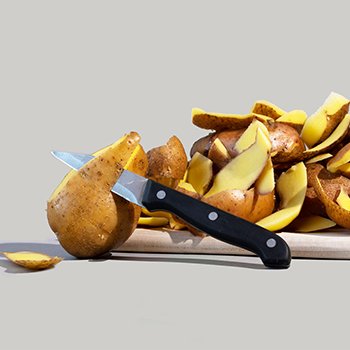จากผลพลอยได้ในอุตสาหกรรมอาหาร ต่อยอดสู่วัตถุดิบมูลค่าสูงและผลิตภัณฑ์ที่หลากหลาย From Food Industry By-products To High-Value Raw Materials and Diversified Products
2283 Views |

By: ผศ.ดร. สุดาทิพย์ แซ่ตั้น
Assist. Prof. Sudathip Sae-tan, Ph.D.
Department of Food Science and Technology
Faculty of Agro-Industry
Kasetsart University
sudathip.sa@ku.th
องค์การอาหารและเกษตรแห่งสหประชาชาติ (Food and Agriculture Organization of the United Nations; FAO) รายงานว่า ปัจจุบันมีการผลิตอาหารอย่างน้อย 4 พันล้านตันต่อปี ก่อให้เกิดผลพลอยได้มากถึง 1 ใน 3 ของวัตถุดิบทั้งหมด โดยผลพลอยได้นี้มักถูกนำไปถมดิน เผาทำลาย หรือผลิตเป็นอาหารสัตว์ ซึ่งไม่สามารถสร้างคุณค่าและมูลค่าทางเศรษฐกิจได้ อย่างไรก็ตามผลพลอยได้ส่วนใหญ่จากอุตสาหกรรมอาหารเหล่านี้ล้วนมีองค์ประกอบที่มีคุณค่าเชิงหน้าที่หรือเชิงสุขภาพที่น่าสนใจ และสามารถนำไปแปรรูปเป็นวัตถุดิบมูลค่าสูงและผลิตภัณฑ์ที่หลากหลาย โดยมีตัวอย่างดังต่อไปนี้
สารพอลิฟีนอล
พอลิฟีนอล คือสารทุติยภูมิในพืชที่มีประโยชน์ด้านสุขภาพที่หลากหลาย ผลพลอยได้จากอุตสาหกรรมแปรรูปผลไม้ที่มักนำมาใช้เพื่อสกัดสารพอลิฟีนอลจำนวนมาก เช่น กากแอปเปิล (apple pomace) จากกระบวนการผลิตน้ำแอปเปิล ซึ่งทั่วโลกจะมีกากแอปเปิลเกิดขึ้นจากอุตสาหกรรมน้ำแอปเปิลประมาณ 12 ล้านตันต่อปี นอกจากนี้เปลือกยังประกอบไปด้วยสารฟลาโวนอยด์ที่มีปริมาณมากกว่าเนื้อแอปเปิลในปริมาณสูงกว่าถึง 3-6 เท่า ไม่เพียงเท่านั้นยังพบสารบางชนิดที่มีประโยชน์และพบเฉพาะบริเวณเปลือกเท่านั้น อย่างสารเควอซิทิน ไกลโคไซด์ (quercetin glycosides) หรือสารพอลิฟีนอลที่ได้จากกากกาแฟและชา ทั้งกรดคลอโรจีนิก (chlorogenic acid) คาเทชิน (catechins) และทีเอฟลาวิน (theaflavins)
ใยอาหาร
ส่วนใหญ่ใยอาหารจากพืชจะเป็นเซลลูโลส หรือพอลิแซ็กคาไรด์ที่ไม่ใช่เซลลูโลสอย่างเฮมิเซลลูโลส เพกติน กัม มูซิเลจ และลิกนิน โดยใยอาหารจากพืชนี้เมื่อพิจารณาถึงความสามารถในการละลายน้ำ ตัวอย่างของผลพลอยได้จากอุตสาหกรรมเกษตรที่มีใยอาหารสูง เช่น เปลือกกล้วย
วิตามินและเกลือแร่
ผักและผลไม้จำนวนมากถูกคัดออกจากกระบวนการผลิตเนื่องจากมีรูปร่างและขนาดที่ไม่ได้มาตรฐาน แต่รู้หรือไม่ว่าวัตถุดิบเหล่านี้ต่างอุดมไปด้วยวิตามินและเกลือแร่ที่หลากหลายไม่ต่างจากผักและผลไม้ที่มีรูปทรงสวยงาม เช่น สารแคโรทีนอยด์ซึ่งพบมากในพืชผักหลากหลายชนิด
นอกจากนี้ ยังสามารถพบเกลือแร่อย่างสังกะสี (zinc) ในเมล็ดและแกนของพืชหลากหลายชนิด หรือแคลเซียมและโพแทสเซียมซึ่งพบได้มากในเปลือกของผลไม้ ขณะที่ผลพลอยได้จากการผลิตชีส หรือโยเกิร์ตสามารถนำไปใช้เป็นแหล่งวัตถุดิบเพื่อสกัดเป็นแคลเซียมได้อีกด้วย
According to a report by the Food and Agriculture Organization of the United Nations (FAO), at least 4 billion tons of food are produced annually, leading to the rise of by-products that account for one-third of all raw materials. These by-products are commonly disposed as landfill or are burnt or are converted into animal feeds, which do not meaningfully add much value to the economy. Most food industry by-products, however, contain chemical components with functional and health properties, which could be converted into various products or raw materials with added value. Some examples are as follows:
Polyphenols
Polyphenol is a secondary metabolite in plants with various health benefits. Many by-products from the fruit-processing industry are usually extracted for polyphenols. Apple pomace from the industrial production of apple juice around the world, for instance, may amount to 12 million tons per year. Furthermore, apple skin contains a rich amount of flavonoids, relatively 3 to 6 times higher than that found in apple flesh. Some other beneficial substances found only in apple skin are, for instance, quercetin glycosides as well as chlorogenic acids, catechins, and theaflavins, which can also be obtained from coffee grounds and tea wastes.
Dietary Fibers
Most plant fibers consist of cellulose or non-cellulosic polysaccharides, such as hemicellulose, pectin, gum, mucilage, and lignin. An example of fiber-rich agricultural waste is banana peel
Vitamins and Minerals
Many fruits and vegetables are sorted out during the production process due to their substandard shapes and sizes, but these raw materials are actually just as rich in vitamins and minerals as their more qualified counterparts with beautiful appearances.
Furthermore, zinc can be found in seeds and cores of various plants, while calcium and potassium are available in many fruit skins or peels. By-products from cheese or yogurt production can be used as raw materials for calcium extraction.
Meet more value-added innovation of food industry by-product from full article.






